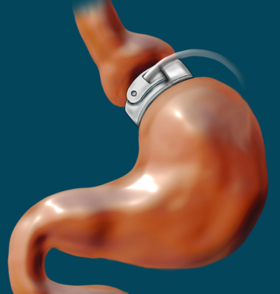Gastric banding
| Adjustable gastric band | |
|---|---|
| Intervention | |

Diagram of an adjustable gastric band
|
|
| ICD-9-CM | 44.95 |
A laparoscopic adjustable gastric band, commonly called a lap-band, A band, or LAGB, is an inflatable silicone device placed around the top portion of the stomach to treat obesity, intended to slow consumption of food and thus reduce the amount of food consumed.
Adjustable gastric band surgery is an example of bariatric surgery designed for obese patients with a body mass index (BMI) of 40 or greater—or between 35 and 40 in cases of patients with certain comorbidities that are known to improve with weight loss, such as sleep apnea, diabetes, osteoarthritis, GERD, hypertension (high blood pressure), or metabolic syndrome, among others.
In February 2011, the United States Food and Drug Administration (FDA) expanded approval of adjustable gastric bands to patients with a BMI between 30 and 40 and one weight-related medical condition, such as diabetes or high blood pressure. However, an adjustable gastric band may be used only after other methods such as diet and exercise have been tried.
The inflatable band is placed around the upper part of the stomach to create a smaller stomach pouch. This slows and limits the amount of food that can be consumed at one time, thus giving the opportunity for the sense of satiety to be met with the release of peptide YY (PYY). It does not decrease gastric emptying time. The individual achieves sustained weight loss by choosing healthy food options, limiting food intake and volume, reducing appetite, and progress of food from the top portion of the stomach to the lower portion digestion.
According to the American Society for Metabolic Bariatric Surgery, bariatric surgery is not an easy option for obesity sufferers. It is a drastic step, and carries the usual pain and risks of any major gastrointestinal surgical operation.
...
Wikipedia
